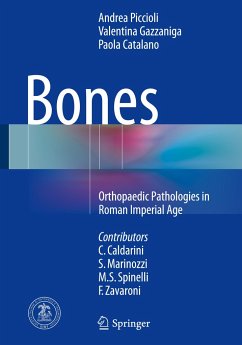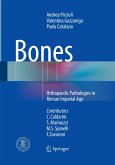This book presents the results of a unique macroscopic and radiological analysis, by X-ray and CT scan, of the bone pathologies of about 1800 subjects who lived at the time of the Roman Empire (first and second centuries A.D.) and whose remains were recovered during the excavation of a suburban necropolis of Rome. The survey, which represents a collaboration between the Italian Society of Orthopaedics and Traumatology and the Special Superintendent for the Archaeological Heritage of Rome, has yielded incredible images of different orthopaedic diseases in a period when no surgical treatment was available: there are cases of infection (osteomyelitis), metabolic disease (gout), hematologic disease (multiple myeloma), traumatic lesions and their complications and degenerative pathology (osteoarthritis, particularly secondary and overload). A multidisciplinary team including orthopaedists, paleopathologists, radiologists and medical historians has evaluated the major groups of bone disease in the population finding out incredible cases and picture of ortho-traumatologic pathologies in a pre-surgical era. The homogeneity of the sample and the number of subjects make this a study of fundamental importance.
"This new book ... presents the results of analysis of over 1800 cases of bone pathology recovered from a recent archaeological excavation outside Rome. ... The studies from the Italian group shed light on medicine in early Rome and the scholarly well researched and illustrated volume is an important contribution to palaeopathological studies and will be of interest to a wide audience including medical historians. All the contributors should be congratulated in producing this fine work of scholarship." (Arpan K. Banerjee, The British Society for the History of Radiology, BSHR, bshr.org.uk, July, 2016)
"This a charming book, and will be of considerable value to anyone interested in Roman medicine and orthopaedic radiology. ... I love this book. I came away with an awareness of the common humanity of all of us, and these bones from imperial Rome have conditions that we would see on our reporting lists today. In particular the book would make an ideal present for anyone interested in Roman history and in bones." (Dr. Adrian Thomas, RAD Magazine, July, 2016)
"This a charming book, and will be of considerable value to anyone interested in Roman medicine and orthopaedic radiology. ... I love this book. I came away with an awareness of the common humanity of all of us, and these bones from imperial Rome have conditions that we would see on our reporting lists today. In particular the book would make an ideal present for anyone interested in Roman history and in bones." (Dr. Adrian Thomas, RAD Magazine, July, 2016)








